Highly Secured Cloud-Based Syslog Disaster Management Thesis
VerifiedAdded on 2019/10/18
|46
|13398
|223
Thesis and Dissertation
AI Summary
This thesis, submitted to Kingston University, explores highly secured cloud-based Syslog disaster management and disaster recovery sites. The research investigates the effectiveness of cloud-based Syslog systems in managing data during disasters, emphasizing the importance of data security through encryption. The study employs a qualitative research methodology, collecting data through primary and secondary methods, and analyzes the role of Syslog in securing data. The findings highlight the benefits of cloud-based Syslog management for disaster recovery, including data protection and efficient management. The thesis is structured into eight chapters, covering the introduction, literature review, technology, design, approach, implementation, evaluation, and conclusion, providing a comprehensive analysis of the topic. It addresses the increasing frequency of disasters and the critical need for robust data management solutions, proposing a solution that utilizes encrypted data within a cloud-based Syslog system to enhance disaster recovery capabilities. The research aims to analyze the cloud-based Syslog data storage in managing disaster sites using encrypted log data.

KINGSTON UNIVERSITY
FACULTY OF ENGINEERING AND COMPUTING
School of Computing
MSc. DEGREE
IN
<State your specialization >
Name: <Student Name>
ID Number: <Student ID>
Project Title: Highly Secured Cloud-Based Syslog Disaster Management
and Disaster Recovery Site with Encrypted Log Data
Supervisor: <Supervisor Name>
Date: <Date of Submission>
FACULTY OF ENGINEERING AND COMPUTING
School of Computing
MSc. DEGREE
IN
<State your specialization >
Name: <Student Name>
ID Number: <Student ID>
Project Title: Highly Secured Cloud-Based Syslog Disaster Management
and Disaster Recovery Site with Encrypted Log Data
Supervisor: <Supervisor Name>
Date: <Date of Submission>
Paraphrase This Document
Need a fresh take? Get an instant paraphrase of this document with our AI Paraphraser

WARRANTY STATEMENT
The information provided are well researched and reliable to be considered as true in the real
context.
i
The information provided are well researched and reliable to be considered as true in the real
context.
i
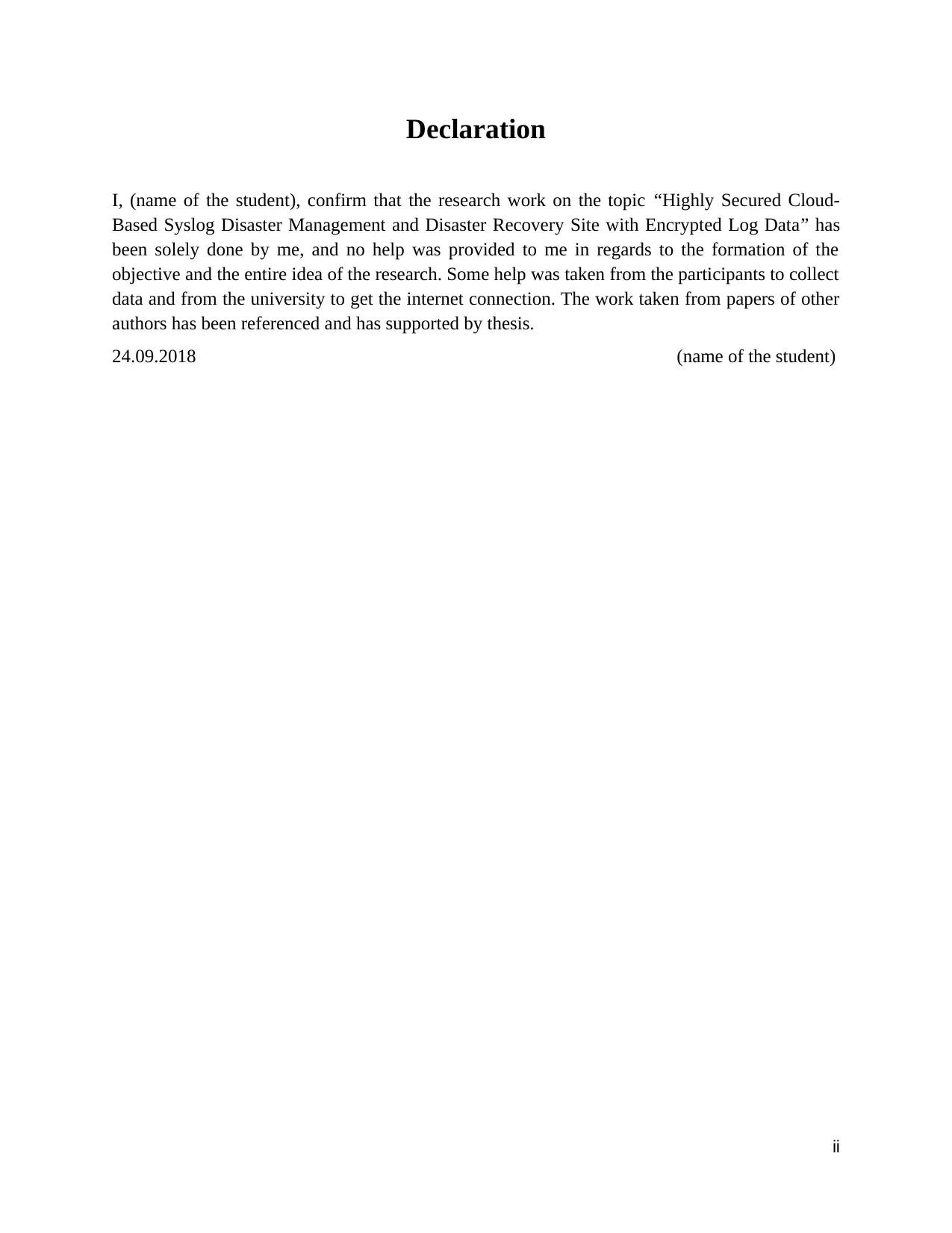
Declaration
I, (name of the student), confirm that the research work on the topic “Highly Secured Cloud-
Based Syslog Disaster Management and Disaster Recovery Site with Encrypted Log Data” has
been solely done by me, and no help was provided to me in regards to the formation of the
objective and the entire idea of the research. Some help was taken from the participants to collect
data and from the university to get the internet connection. The work taken from papers of other
authors has been referenced and has supported by thesis.
24.09.2018 (name of the student)
ii
I, (name of the student), confirm that the research work on the topic “Highly Secured Cloud-
Based Syslog Disaster Management and Disaster Recovery Site with Encrypted Log Data” has
been solely done by me, and no help was provided to me in regards to the formation of the
objective and the entire idea of the research. Some help was taken from the participants to collect
data and from the university to get the internet connection. The work taken from papers of other
authors has been referenced and has supported by thesis.
24.09.2018 (name of the student)
ii
⊘ This is a preview!⊘
Do you want full access?
Subscribe today to unlock all pages.

Trusted by 1+ million students worldwide
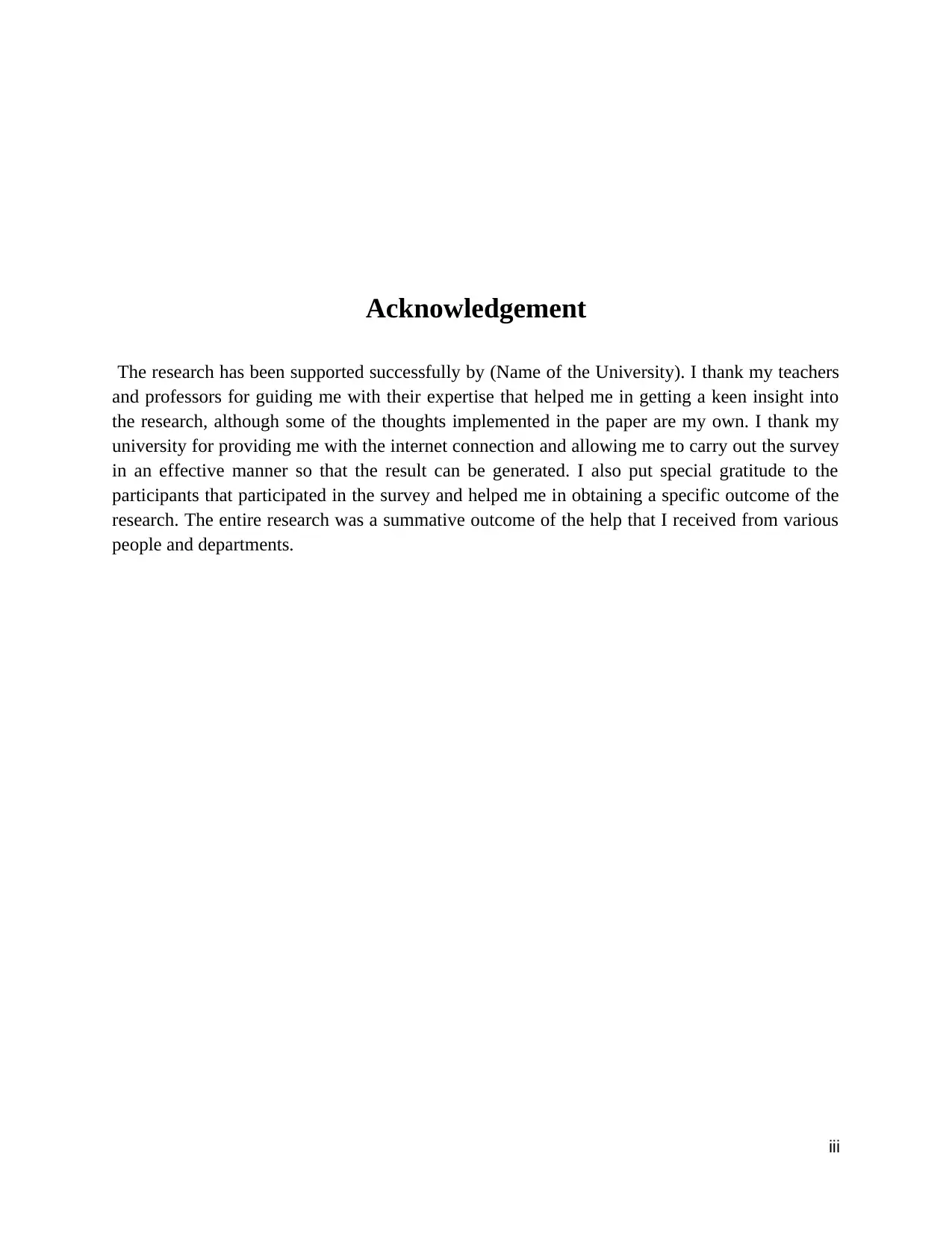
Acknowledgement
The research has been supported successfully by (Name of the University). I thank my teachers
and professors for guiding me with their expertise that helped me in getting a keen insight into
the research, although some of the thoughts implemented in the paper are my own. I thank my
university for providing me with the internet connection and allowing me to carry out the survey
in an effective manner so that the result can be generated. I also put special gratitude to the
participants that participated in the survey and helped me in obtaining a specific outcome of the
research. The entire research was a summative outcome of the help that I received from various
people and departments.
iii
The research has been supported successfully by (Name of the University). I thank my teachers
and professors for guiding me with their expertise that helped me in getting a keen insight into
the research, although some of the thoughts implemented in the paper are my own. I thank my
university for providing me with the internet connection and allowing me to carry out the survey
in an effective manner so that the result can be generated. I also put special gratitude to the
participants that participated in the survey and helped me in obtaining a specific outcome of the
research. The entire research was a summative outcome of the help that I received from various
people and departments.
iii
Paraphrase This Document
Need a fresh take? Get an instant paraphrase of this document with our AI Paraphraser

iv
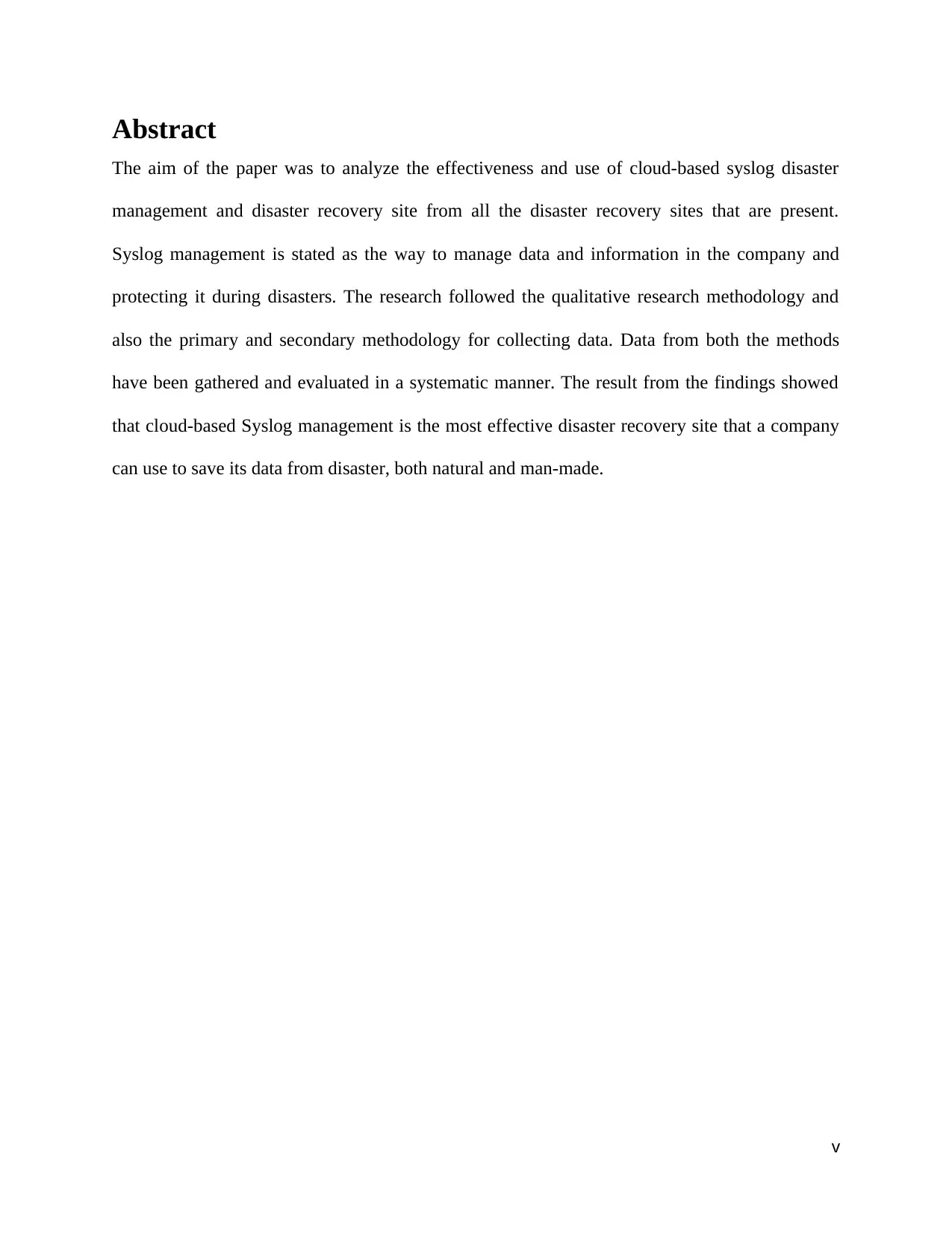
Abstract
The aim of the paper was to analyze the effectiveness and use of cloud-based syslog disaster
management and disaster recovery site from all the disaster recovery sites that are present.
Syslog management is stated as the way to manage data and information in the company and
protecting it during disasters. The research followed the qualitative research methodology and
also the primary and secondary methodology for collecting data. Data from both the methods
have been gathered and evaluated in a systematic manner. The result from the findings showed
that cloud-based Syslog management is the most effective disaster recovery site that a company
can use to save its data from disaster, both natural and man-made.
v
The aim of the paper was to analyze the effectiveness and use of cloud-based syslog disaster
management and disaster recovery site from all the disaster recovery sites that are present.
Syslog management is stated as the way to manage data and information in the company and
protecting it during disasters. The research followed the qualitative research methodology and
also the primary and secondary methodology for collecting data. Data from both the methods
have been gathered and evaluated in a systematic manner. The result from the findings showed
that cloud-based Syslog management is the most effective disaster recovery site that a company
can use to save its data from disaster, both natural and man-made.
v
⊘ This is a preview!⊘
Do you want full access?
Subscribe today to unlock all pages.

Trusted by 1+ million students worldwide
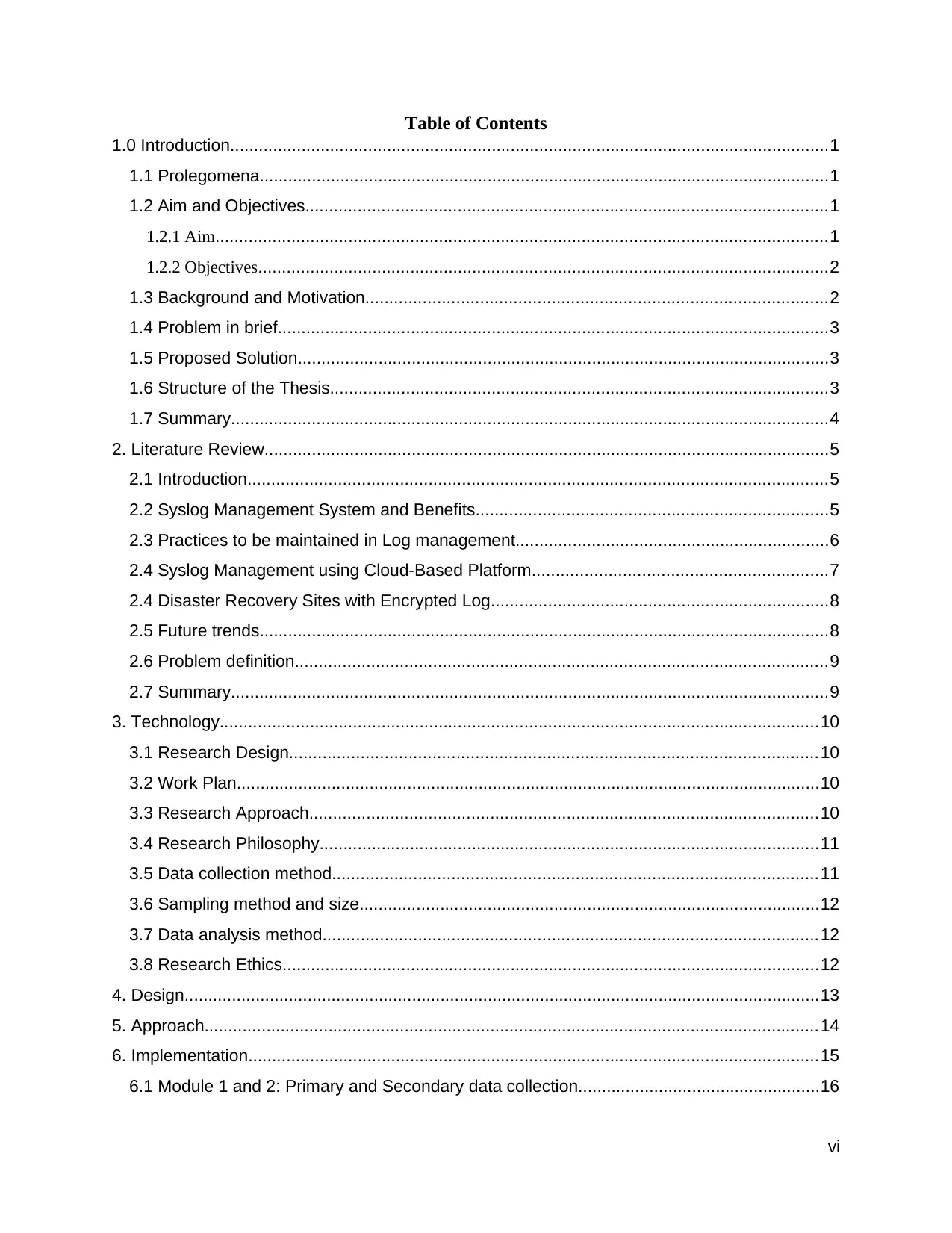
Table of Contents
1.0 Introduction..............................................................................................................................1
1.1 Prolegomena........................................................................................................................1
1.2 Aim and Objectives..............................................................................................................1
1.2.1 Aim.................................................................................................................................1
1.2.2 Objectives........................................................................................................................2
1.3 Background and Motivation.................................................................................................2
1.4 Problem in brief....................................................................................................................3
1.5 Proposed Solution................................................................................................................3
1.6 Structure of the Thesis.........................................................................................................3
1.7 Summary..............................................................................................................................4
2. Literature Review.......................................................................................................................5
2.1 Introduction..........................................................................................................................5
2.2 Syslog Management System and Benefits..........................................................................5
2.3 Practices to be maintained in Log management..................................................................6
2.4 Syslog Management using Cloud-Based Platform..............................................................7
2.4 Disaster Recovery Sites with Encrypted Log.......................................................................8
2.5 Future trends........................................................................................................................8
2.6 Problem definition................................................................................................................9
2.7 Summary..............................................................................................................................9
3. Technology..............................................................................................................................10
3.1 Research Design...............................................................................................................10
3.2 Work Plan...........................................................................................................................10
3.3 Research Approach...........................................................................................................10
3.4 Research Philosophy.........................................................................................................11
3.5 Data collection method......................................................................................................11
3.6 Sampling method and size.................................................................................................12
3.7 Data analysis method........................................................................................................12
3.8 Research Ethics.................................................................................................................12
4. Design......................................................................................................................................13
5. Approach.................................................................................................................................14
6. Implementation........................................................................................................................15
6.1 Module 1 and 2: Primary and Secondary data collection...................................................16
vi
1.0 Introduction..............................................................................................................................1
1.1 Prolegomena........................................................................................................................1
1.2 Aim and Objectives..............................................................................................................1
1.2.1 Aim.................................................................................................................................1
1.2.2 Objectives........................................................................................................................2
1.3 Background and Motivation.................................................................................................2
1.4 Problem in brief....................................................................................................................3
1.5 Proposed Solution................................................................................................................3
1.6 Structure of the Thesis.........................................................................................................3
1.7 Summary..............................................................................................................................4
2. Literature Review.......................................................................................................................5
2.1 Introduction..........................................................................................................................5
2.2 Syslog Management System and Benefits..........................................................................5
2.3 Practices to be maintained in Log management..................................................................6
2.4 Syslog Management using Cloud-Based Platform..............................................................7
2.4 Disaster Recovery Sites with Encrypted Log.......................................................................8
2.5 Future trends........................................................................................................................8
2.6 Problem definition................................................................................................................9
2.7 Summary..............................................................................................................................9
3. Technology..............................................................................................................................10
3.1 Research Design...............................................................................................................10
3.2 Work Plan...........................................................................................................................10
3.3 Research Approach...........................................................................................................10
3.4 Research Philosophy.........................................................................................................11
3.5 Data collection method......................................................................................................11
3.6 Sampling method and size.................................................................................................12
3.7 Data analysis method........................................................................................................12
3.8 Research Ethics.................................................................................................................12
4. Design......................................................................................................................................13
5. Approach.................................................................................................................................14
6. Implementation........................................................................................................................15
6.1 Module 1 and 2: Primary and Secondary data collection...................................................16
vi
Paraphrase This Document
Need a fresh take? Get an instant paraphrase of this document with our AI Paraphraser
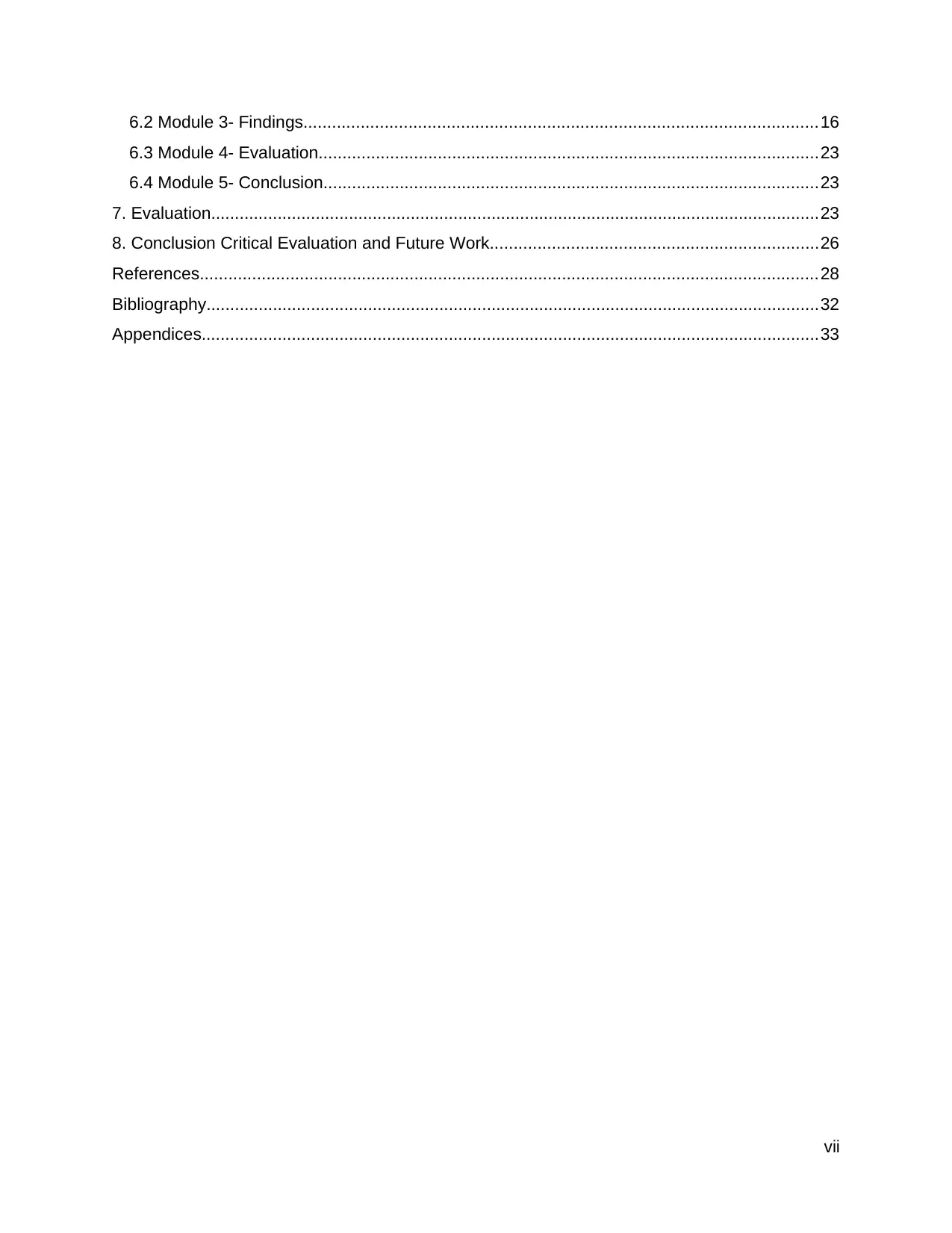
6.2 Module 3- Findings............................................................................................................16
6.3 Module 4- Evaluation.........................................................................................................23
6.4 Module 5- Conclusion........................................................................................................23
7. Evaluation................................................................................................................................23
8. Conclusion Critical Evaluation and Future Work.....................................................................26
References..................................................................................................................................28
Bibliography.................................................................................................................................32
Appendices..................................................................................................................................33
vii
6.3 Module 4- Evaluation.........................................................................................................23
6.4 Module 5- Conclusion........................................................................................................23
7. Evaluation................................................................................................................................23
8. Conclusion Critical Evaluation and Future Work.....................................................................26
References..................................................................................................................................28
Bibliography.................................................................................................................................32
Appendices..................................................................................................................................33
vii

List of Tables
Table 1- Modules of the paper
viii
Table 1- Modules of the paper
viii
⊘ This is a preview!⊘
Do you want full access?
Subscribe today to unlock all pages.

Trusted by 1+ million students worldwide
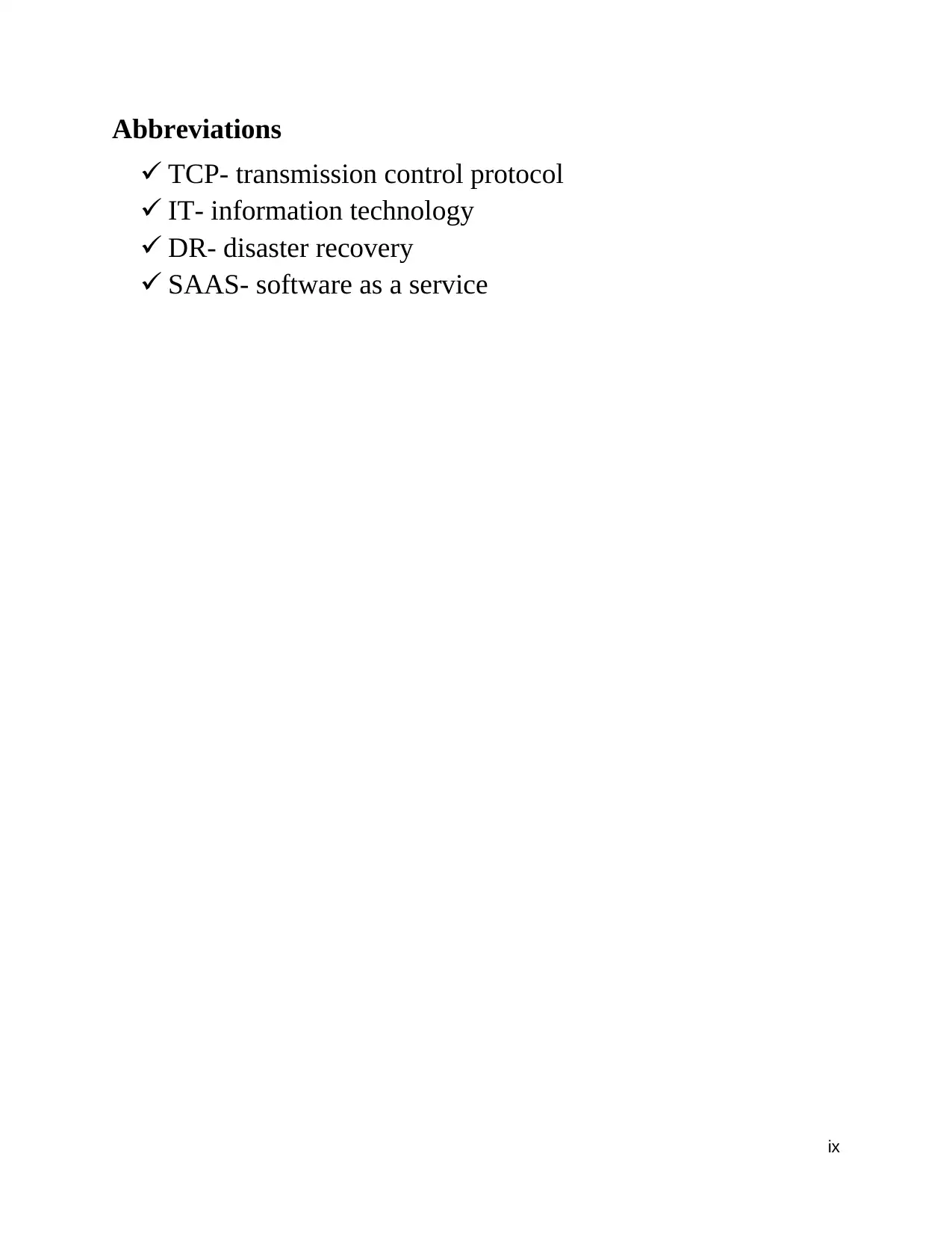
Abbreviations
TCP- transmission control protocol
IT- information technology
DR- disaster recovery
SAAS- software as a service
ix
TCP- transmission control protocol
IT- information technology
DR- disaster recovery
SAAS- software as a service
ix
Paraphrase This Document
Need a fresh take? Get an instant paraphrase of this document with our AI Paraphraser

1.0 Introduction
1.1 Prolegomena
Cloud-based syslog disaster management is one of the most recently used systems to recover disaster
affected sites. The importance of cloud-based Syslog management system is increasing over the years due
to an increase in the rate of disaster. Disaster management helps in controlling the lives and property in
the economy that id destroyed by any disaster incident. According to Song et al. (2013), disaster
management includes all kinds of activity that helps in controlling the impacts of a disaster. The rate of
managing the disaster is not easy and involves various crucial processes to be done in a systematic way.
Thus, technology is playing an important role in controlling and managing the after-effects of all kinds of
disaster in a scenario. According to the statistic, the rate of different types of disaster that has increased
drastically as it is seen that the earthquake has increased by 59 percent and more than 40 million is prone
to floods. The rate is increasing from time to time affecting a huge percentage of life and property on
earth. Further, it is seen that about $9.8 billion has been lost due to the various disasters that took place in
the past few years in India (O'Brien et al. 2006). Such a fast increase in disaster and the urgency of
managing the loss that is made from it led to the use of cloud-based syslog disaster management. There
have been various works conducted in this field to see the ability of highly secure cloud-based Syslog
data that can effectively manage disaster and it's after effects.
The thesis has identified the importance of cloud-based syslog disaster management and disaster
recovery sites and the problem of security related to the system as the research problem. Further, the
research proposes a solution to the system such as high-security services and encrypted data usage in the
cloud-based disaster management system while analyzing the role of the syslog system in securing the
data that can be used in managing disaster in future.
1.2 Aim and Objectives
1.2.1 Aim
The aim of the paper forms an integral part of the research as it has offered the researcher to move in a
systematic format with the investigation process. It streamlines the entire area of study in one particular
direction.
The aim of the paper is to critically analyze the role that cloud-based Syslog data storage plays in
managing the disaster sites using encrypted log data. The paper aims at the disaster management while
studying the cloud-based Syslog management system and not for any other purpose.
1
1.1 Prolegomena
Cloud-based syslog disaster management is one of the most recently used systems to recover disaster
affected sites. The importance of cloud-based Syslog management system is increasing over the years due
to an increase in the rate of disaster. Disaster management helps in controlling the lives and property in
the economy that id destroyed by any disaster incident. According to Song et al. (2013), disaster
management includes all kinds of activity that helps in controlling the impacts of a disaster. The rate of
managing the disaster is not easy and involves various crucial processes to be done in a systematic way.
Thus, technology is playing an important role in controlling and managing the after-effects of all kinds of
disaster in a scenario. According to the statistic, the rate of different types of disaster that has increased
drastically as it is seen that the earthquake has increased by 59 percent and more than 40 million is prone
to floods. The rate is increasing from time to time affecting a huge percentage of life and property on
earth. Further, it is seen that about $9.8 billion has been lost due to the various disasters that took place in
the past few years in India (O'Brien et al. 2006). Such a fast increase in disaster and the urgency of
managing the loss that is made from it led to the use of cloud-based syslog disaster management. There
have been various works conducted in this field to see the ability of highly secure cloud-based Syslog
data that can effectively manage disaster and it's after effects.
The thesis has identified the importance of cloud-based syslog disaster management and disaster
recovery sites and the problem of security related to the system as the research problem. Further, the
research proposes a solution to the system such as high-security services and encrypted data usage in the
cloud-based disaster management system while analyzing the role of the syslog system in securing the
data that can be used in managing disaster in future.
1.2 Aim and Objectives
1.2.1 Aim
The aim of the paper forms an integral part of the research as it has offered the researcher to move in a
systematic format with the investigation process. It streamlines the entire area of study in one particular
direction.
The aim of the paper is to critically analyze the role that cloud-based Syslog data storage plays in
managing the disaster sites using encrypted log data. The paper aims at the disaster management while
studying the cloud-based Syslog management system and not for any other purpose.
1

1.2.2 Objectives
The aim of the paper gives way to various research objective on which the entire investigation process
was based on.
The objective of the research breaks the aim of the paper into various parts so that these parts can be
studied separately and intensively. The aim of the paper is:
to analyze the concept of Syslog system
to critically examine the importance that cloud-based technology plays in the syslog system in which
it manages data in an encrypted format
to examine the presence of highly sensitive Syslog data in the area of investigation in the disaster
management sites
to critically analyze the role of cloud-based Syslog data plays in managing the disaster recovery sites
in which data is stored in encrypted format
1.3 Background and Motivation
The research has been based on various facts that have motivated the researcher to conduct research on
this ground. This section describes the motivation that the researcher got in conducting the research in this
area. The increase in disaster over the period is one of the most important criteria and motivation that the
researcher got to choose disaster management by studying the role of cloud-based Syslog (Okmianski
2009). The disaster has been increasing over the years, and the ways in which the affected sites can be
recovered is not easy as there are various challenges that have to be studied and data that needs to be
collected before reaching a disaster-affected site. Data forms an important part of recovering the site from
a disaster because without knowing the data of the company and other information the recovery system
cannot be installed in that place. Data forms an integral part to decide the type of recovery is needed by
the site and to conduct careful planning about it. The risk of the disaster can only be managed with proper
availability and collection of data from the site. The disaster management organization is working day
and night to protect the data. However, the data has to be shared with the management team so that
appropriate planning can be done. Thus, a data management technology is important to manage the data
in a better way (Ray et al. 2013). Cloud-based Syslog system is one of the most recent data management
techniques that have been used in the disaster-affected area. Syslog is a system log that uses the server to
save the data in the form of a log and allows sending a message to a centrally located server. The data is
then shared on the server on a central platform and can be used to manage critical events and disasters.
However, over the time the importance of security for this data has been of utmost concern as security in
cloud system has been questioned many times. Research has been conducted on this field stating that the
system is protected with encryption to prevent any kind of data breach to happen in the system server.
This is because any modification in the data will hamper the disaster management process of the affected
site.
Thus, the emergency scenario of the economy that is being affected by the disaster, the emergency of
managing the disaster-affected sites, the importance of syslog server in managing the data that is used for
the recovery work and others altogether formed the motivation for the research. The research is of utmost
importance for the economy as well as the disaster management team that works their best to control the
loss. This is because the investigation will help in informing the disaster management organization about
2
The aim of the paper gives way to various research objective on which the entire investigation process
was based on.
The objective of the research breaks the aim of the paper into various parts so that these parts can be
studied separately and intensively. The aim of the paper is:
to analyze the concept of Syslog system
to critically examine the importance that cloud-based technology plays in the syslog system in which
it manages data in an encrypted format
to examine the presence of highly sensitive Syslog data in the area of investigation in the disaster
management sites
to critically analyze the role of cloud-based Syslog data plays in managing the disaster recovery sites
in which data is stored in encrypted format
1.3 Background and Motivation
The research has been based on various facts that have motivated the researcher to conduct research on
this ground. This section describes the motivation that the researcher got in conducting the research in this
area. The increase in disaster over the period is one of the most important criteria and motivation that the
researcher got to choose disaster management by studying the role of cloud-based Syslog (Okmianski
2009). The disaster has been increasing over the years, and the ways in which the affected sites can be
recovered is not easy as there are various challenges that have to be studied and data that needs to be
collected before reaching a disaster-affected site. Data forms an important part of recovering the site from
a disaster because without knowing the data of the company and other information the recovery system
cannot be installed in that place. Data forms an integral part to decide the type of recovery is needed by
the site and to conduct careful planning about it. The risk of the disaster can only be managed with proper
availability and collection of data from the site. The disaster management organization is working day
and night to protect the data. However, the data has to be shared with the management team so that
appropriate planning can be done. Thus, a data management technology is important to manage the data
in a better way (Ray et al. 2013). Cloud-based Syslog system is one of the most recent data management
techniques that have been used in the disaster-affected area. Syslog is a system log that uses the server to
save the data in the form of a log and allows sending a message to a centrally located server. The data is
then shared on the server on a central platform and can be used to manage critical events and disasters.
However, over the time the importance of security for this data has been of utmost concern as security in
cloud system has been questioned many times. Research has been conducted on this field stating that the
system is protected with encryption to prevent any kind of data breach to happen in the system server.
This is because any modification in the data will hamper the disaster management process of the affected
site.
Thus, the emergency scenario of the economy that is being affected by the disaster, the emergency of
managing the disaster-affected sites, the importance of syslog server in managing the data that is used for
the recovery work and others altogether formed the motivation for the research. The research is of utmost
importance for the economy as well as the disaster management team that works their best to control the
loss. This is because the investigation will help in informing the disaster management organization about
2
⊘ This is a preview!⊘
Do you want full access?
Subscribe today to unlock all pages.

Trusted by 1+ million students worldwide
1 out of 46
Related Documents
Your All-in-One AI-Powered Toolkit for Academic Success.
+13062052269
info@desklib.com
Available 24*7 on WhatsApp / Email
![[object Object]](/_next/static/media/star-bottom.7253800d.svg)
Unlock your academic potential
Copyright © 2020–2025 A2Z Services. All Rights Reserved. Developed and managed by ZUCOL.





